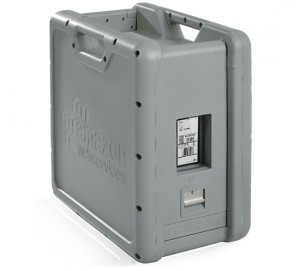This week Amazon Web Services announced a new data service capable of sending 50TB into the cloud. Great, more bandwidth demand, right? Nope, they’re shipping it in a box.
In the prior decade, former Level 3 CEO James Crowe used to talk about how the networking industry at some point has to compete with shipping DVDs full of content by truck. One would think that with 100G well in hand, 400G on the way, and all manner of direct-to-the-cloud bandwidth, we might have gotten past that point by now. Netflix’s streaming business is the hot one now relative to the DVDs, after all.
But 50TB can take weeks to send even with today’s networks. Besides, UPS and Fedex and their friends have really taken it up a notch themselves in this era of web shopping. It’s really quite amazing how omnipresent those vans are, in my neighborhood at least.
 So Amazon now lets its customers upload their data via the Snowball, a fifty-pound, weather-proof, shock-proof box full of encrypted, tamper-proof storage. The price is $200 per transfer plus shipping, which for 50Tb still costs far less than the fiberoptic alternative and takes a whole lot less time.
So Amazon now lets its customers upload their data via the Snowball, a fifty-pound, weather-proof, shock-proof box full of encrypted, tamper-proof storage. The price is $200 per transfer plus shipping, which for 50Tb still costs far less than the fiberoptic alternative and takes a whole lot less time.
I recall a few years ago in South Africa a carrier pigeon humbled the local ISP with a flash drive strapped to its leg, which is just a simpler version of the same thing. For small payloads, fiberoptic networks are truly awesome of course. When it comes to consumers, the last mile can still be like drinking from a firehose for most usages, even streaming video. But for Big Data, the metaphor is still pushing a watermelon through a straw.
If you haven't already, please take our Reader Survey! Just 3 questions to help us better understand who is reading Telecom Ramblings so we can serve you better!
Categories: Big Data · Internet Traffic






The Media & Entertainment industry has been relying more often than not on shipping physical media…even today.
In the early to mid-90’s I worked with post production companies in Vancouver, BC. My product for them was the transfer of BLOB’s through my network to LA or wherever. My network had a spur into Vancouver with POP’s in Seattle, Oakland, San Jose, and LA at the time. Other POP’s in NYC, and other major markets were in process. The business model required the customers to pay for access and CPE that I provided. Fees were generated by usage. I had moved the intelligence into the network then. This business model will still work today.
one day a FedEx store in every city will have a 100Gbps internet connection so that ANYONE can upload ANY amount of data they need to their Cloud Service Provider by driving down the street with their hard drive.
or better yet, every Apple store will have that 100Gbps connection…
or every Microsoft retail store will have one too…
Why drive to a store? Bezos will figure out to make the Snowball weigh less than 5 lbs and will have his fleet of drones deliver them to homes and businesses.
That thought does give a whole new hue to image of the carrier pigeon with the flash drive strapped to its leg…
I thought the whole idea behind Big Data was to process it in place (you know…MapReduce).